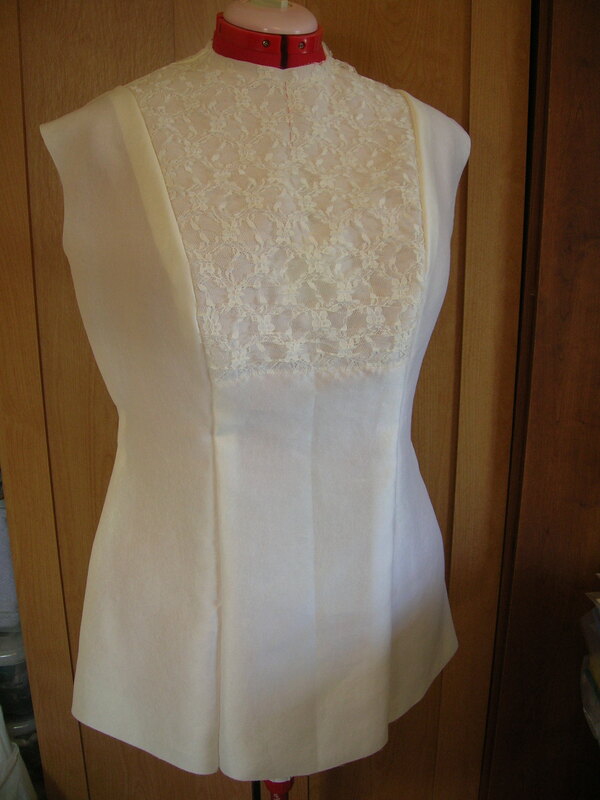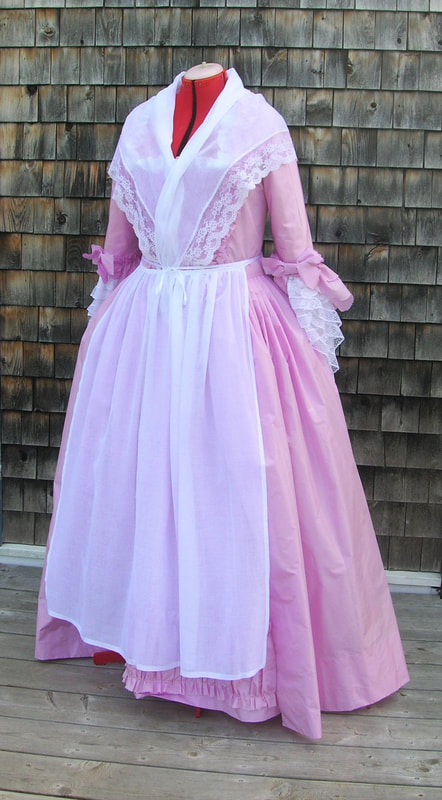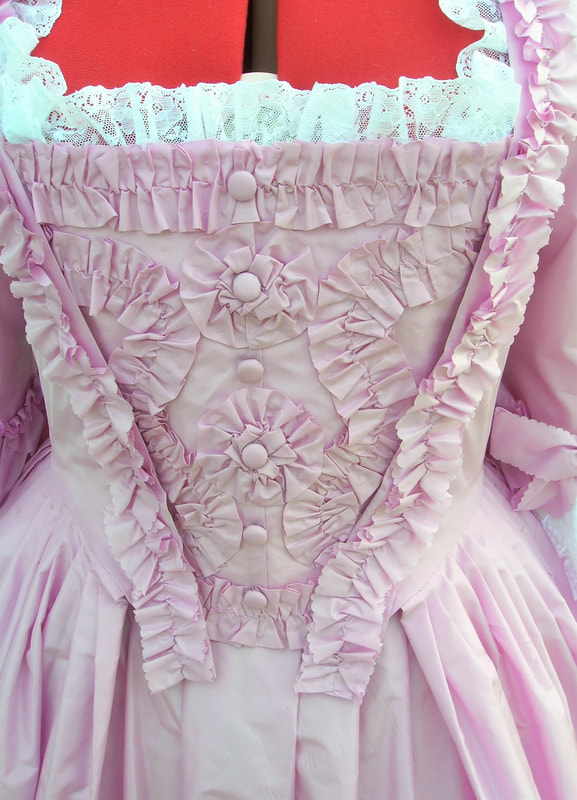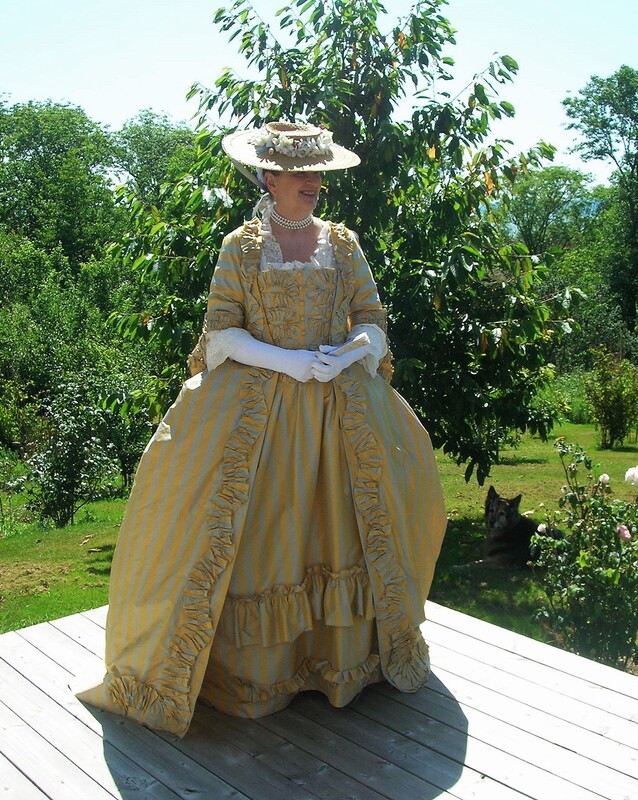|
Before I say anything about this gown, I want to point out that the description -- robe à la polonaise -- is historically correct. I know there has been a great deal of discussion over the use of the word "polonaise" in describing 18thC. fashions, so much so that I feel compelled to try to clear up the confusion -- look for my article (in the "Research & Essays" section) soon! In the meantime, here is my robe à la polonaise that almost exactly replicates a ca. 1775 extant gown in the collection of the Victoria & Albert Museum (U.K.). The museum indicates that the original gown is of Scottish origin, which seemed ideal for my planned portrayal of a middle/upper middle class Scottish lady of the 1770's. The gown is in the "long-back English gown" style which persisted through several decades of the 18thC., first in early 1730's mantuas, and later (1780's) in many of the gowns worn with rumps to create an exaggerated back silhouette. Since my replica was intended to be worn "à la polonaise", it has only a very short train at back. In retrospect, I would have made the entire gown floor length, but fortunately the tissue-taffeta like hand of the silk allows for the back to be pulled up and stay "puffed up" in place quite easily. This gown was relatively simple from a construction viewpoint, with a centre front hook and eye closure and minimal surface decoration based on the V&A original. I began with my usual English gown linen lining (foundation), and added lacing panels below the front closure for extra security, a feature seen in a number of extant gowns of the era. The long centre back panel was pleated onto the linen lining, with the folds opening into the back skirts below the waistline. The rest of the skirts were very finely pleated into the bodice. Although I do have a gold-coloured silk taffeta petticoat that is close to the one displayed in the V&A photos, I decided to make a petticoat from some lovely shot silk dupioni taffeta that almost exactly matches the old rose colour in the stripes of the gown. My gown fabric was also a low-slub, quality striped silk dupioni with a whisper-like weight and fine, crisp texture.
My only disappointment with this gown: unfortunately the striped dupioni did not take well to pinking: the edges of most of my applied ruching almost immediately began to fray and shred! Lesson learned (I really should have known better). Next time I use dupioni, all the edges of the trim will be turned under and hemmed first, then ruched or pleated -- without the pinking! Update: As it turned out, the shredded edges of the trim bothered me so much that I decided to remove all the original pleated trim, then re-cut and make new trim, turning all the edges under a scant 0.5cm and hand-hemming them before pleating and hand-sewing them onto the gown. I'm now glad I spent the time and effort fixing it, as I no longer have to worry about messy and embarrassing looking strings of frayed silk trailing from my bodice, and the trim disintegrating and disappearing as I walked! Dupioni does not behave for all those lovely pinked 18thC. furbelows.
1 Comment
I enjoy making sacque gowns, as the elegant result always seems worth the dozens of hours of careful planning and hand sewing. This robe à la française was no exception. Made from a luscious iridescent silk taffeta of blue tones shot with golden coloured weft threads, the textile has a trompe l'oeil character: from any distance the blue and gold threads of the weave merge so that the overall appearance is a soft, warm taupe with bands of warm grey. But up close the colour shimmers and shifts. It almost has a sparkling effect! So what I initially thought was a rather dull-coloured fabric has turned out to be a stunning textile, especially against the metallic gold trim. The 18th century embellishments of ruching, puffings, and flounces serve to magnify the shimmering effect of the silk. This gown was styled after a (presumed) French sacque gown currently in a German collection. The type of gown, with its extensive embellishment and metallic edging trim, would have been fashionable for evening wear by wealthier classes in the mid-18thC. Unfortunately, cameras have a difficult time capturing the true effect of iridescent or shot silk. You'll see the difference below, between photos taken of the gown in light shade and the pictures at the end taken in bright sunlight. It was almost too much shimmer and shine in full sunlight -- this is a gown meant for candlelight! See my notes on creating this taupe gown under the "Blog" heading!
The idea of making this gown began in early 2021, sparked by a lucky fabric find. I came across over 6.0 metres of 152cm wide (!!!) cotton on sale in a small local shop, the fabric woven in a reduced-scale sett pattern of the official Nova Scotia tartan (Nova Scotia being my current home Province). Buying the "real thing" at that time, i.e. the true Nova Scotia tartan in 100% wool, was not an option at the usual price of at least $50 per metre. Besides, I felt the cotton fabric was a better, more comfortable (and washable!) choice for upcoming summer wear, when we all hoped Covid might disappear and historical events re-appear. Alas, Covid had other ideas. But being ever the incurable optimist, I made the gown anyway, and the bright, cheery, positive colour of the cotton fabric made it all the more enjoyable to work with. Some photos of me wearing the gown on a blustery spring day in 2021 are included in my comical blog/video at the link below, but I've also added pictures here for reference. This gown was cut in the "long-back" English style, and worn over my "go-to" iridescent yellow taffeta petticoat. Incidentally, please don't use "en fourreau" when referring to these types of gowns -- to see why, read my academic paper on the subject here: All in all, this gown was a simple and fun project at a time when I needed distraction in the depths of the Covid pandemic. I'm still hoping I may have a chance to enjoy wearing it at a live event!
This project was a true adventure in reproducing as faithfully as possible a ca.1764 English gown from the iconic image of Lady Howe, by Gainsborough. I've chosen a few representative photos of the gown with and without accessories, on my mannequin and as I wore it. Being a "Covid Project", this creation never got to be worn at an event, but I'm hoping this coming summer of 2022 will be different! To read all the details of constructing this ensemble -- consisting of petticoat, stomacher (faux compère), gown, engageantes, tucker, apron, and fichu -- click on the link below to Part 1 of my blog article, which includes photos documenting the construction steps. Parts 2 through 4 follow the project to completion.
This was a true labour of love, in a colour I normally would never be drawn to (orchid pink), but which, in the end result, seemed just the right choice for this ensemble. For those who follow my adventures in making 18th century reproductions, it's no secret that I particularly love the robe à la française style (rather unappealingly, although at least pithily, referred to as a "sacque" or "sack" gown in English). This type of gown is in my view the utmost of elegance, and is flattering for almost any woman, regardless of her figure or her age. It's clear why these graceful creations remained in fashion for such a long period in the 18th century. My favourite sacque of those I've made is this yellow and silver striped taffeta gown, constructed as closely as possible after an extant gown from a private collection. I was fortunate enough to be able to enjoy wearing it at the 18thC. "Natal Days" celebration in our historic town of Annapolis Royal in August, 2019, just before Covid hit. Since that time, the annual event has not been held due to public health measures. A small collection of photos is included below (most taken at historic Fort Anne), but to see and read much more about its making, go to my blog article here:
|
OverviewA photo portfolio, arranged by historical era, of my work in replica antique garments. Click on any category entry below to see contents. Categories
All
Archives
June 2023
|







































































































 RSS Feed
RSS Feed